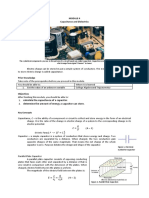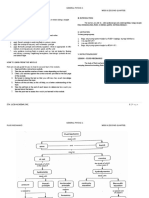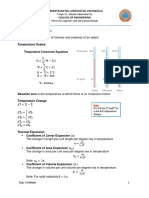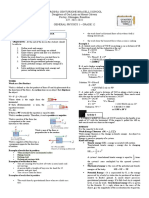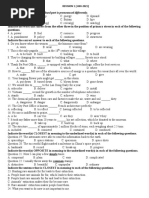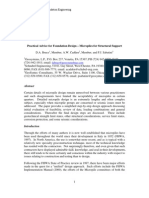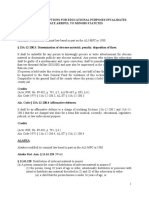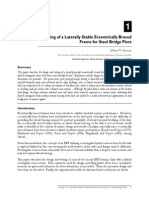100%(1)100% found this document useful (1 vote)
572 viewsPascal Archimedes Bernoulli
Pascal Archimedes Bernoulli
Uploaded by
Rj BengilThe document discusses Archimedes' principle and how it was discovered. It explains that Archimedes figured out a method to determine if a gold crown was pure gold or mixed with other metals by measuring its density. He realized that the buoyant force on an object is equal to the density of the fluid multiplied by the volume of fluid displaced. This principle explains why boats can float even if the material is denser than water. It also allows submarines to control their depth by adjusting their average density.
Copyright:
© All Rights Reserved
Available Formats
Download as DOCX, PDF, TXT or read online from Scribd
Pascal Archimedes Bernoulli
Pascal Archimedes Bernoulli
Uploaded by
Rj Bengil100%(1)100% found this document useful (1 vote)
572 views2 pagesThe document discusses Archimedes' principle and how it was discovered. It explains that Archimedes figured out a method to determine if a gold crown was pure gold or mixed with other metals by measuring its density. He realized that the buoyant force on an object is equal to the density of the fluid multiplied by the volume of fluid displaced. This principle explains why boats can float even if the material is denser than water. It also allows submarines to control their depth by adjusting their average density.
Original Description:
Pascal Principle
Archimedes Principle (Buoyancy)
Bernoulli's Equation
Copyright
© © All Rights Reserved
Available Formats
DOCX, PDF, TXT or read online from Scribd
Share this document
Did you find this document useful?
Is this content inappropriate?
The document discusses Archimedes' principle and how it was discovered. It explains that Archimedes figured out a method to determine if a gold crown was pure gold or mixed with other metals by measuring its density. He realized that the buoyant force on an object is equal to the density of the fluid multiplied by the volume of fluid displaced. This principle explains why boats can float even if the material is denser than water. It also allows submarines to control their depth by adjusting their average density.
Copyright:
© All Rights Reserved
Available Formats
Download as DOCX, PDF, TXT or read online from Scribd
Download as docx, pdf, or txt
100%(1)100% found this document useful (1 vote)
572 views2 pagesPascal Archimedes Bernoulli
Pascal Archimedes Bernoulli
Uploaded by
Rj BengilThe document discusses Archimedes' principle and how it was discovered. It explains that Archimedes figured out a method to determine if a gold crown was pure gold or mixed with other metals by measuring its density. He realized that the buoyant force on an object is equal to the density of the fluid multiplied by the volume of fluid displaced. This principle explains why boats can float even if the material is denser than water. It also allows submarines to control their depth by adjusting their average density.
Copyright:
© All Rights Reserved
Available Formats
Download as DOCX, PDF, TXT or read online from Scribd
Download as docx, pdf, or txt
You are on page 1of 2
ARCHIMEDES PRINCIPLE
As you can imagine, there is definitely more to whether
an object floats or not than just average density. For
example, why do some objects float higher in the water
than others? And why is it easier to lift objects
underwater than in the air? To answer these questions,
youll need to understand the concept of buoyancy, a
force which is exerted by a fluid on an object, opposing
the objects weight.
It is rumored that the Greek philosopher and scientist
Archimedes, around 250 B.C., was asked by King Hiero II
to help with a problem. King Hiero II had ordered a fancy
golden crown from a goldsmith. However, the king was
concerned that the goldsmith may have taken his
money and mixed some silver in with the crown instead
of crafting the crown out of pure gold. He asked
Archimedes if there was a way to determine if the crown
was pure gold.
Archimedes puzzled over the problem for some time,
coming up with the solution while he was in the bath tub
one evening. When Archimedes submerged himself in
the tub, he noticed that the amount of water that spilled
over the rim of the tub was equal to the volume of water
he displaced.
Using this method, he could place the crown in a bowl
full of water. The amount of water that spilled over could
be measured and used to tell the volume of the crown.
By then dividing the mass of the crown by the volume,
he could obtain the density of the crown, and compare
the density to that of gold, determining if the crown was
pure gold. According to legend, he was so excited he
popped out of the tub and ran through the streets naked
yelling Eureka! Eureka! (Greek for I found it! I found
it!)
Answer: First, draw a free body diagram (FBD)
of the situation, realizing that you have the
force of gravity (mg) pulling down, the buoyant
force upward, and the force of tension in the
cable upward.
Because the shark tank is at equilibrium under
the water, the net force on it must be zero,
therefore the upward forces must balance the
downward forces. You can write this using
Newtons 2nd Law in the y-direction as:
Finally, you can use this equation to solve for the force
of tension in the cable.
Question: A rectangular boat made out of concrete
with a mass of 3000 kg floats on a freshwater lake
(=1000 kg/m3). If the bottom area of the boat is 6 m 2,
how much of the boat is submerged?
Answer: Because the boat is floating on the lake, the
magnitude of the buoyant force must be equal to the
magnitude of the weight of the boat. (FB=mg).
Since the boat is rectangular, you can write its volume
(V) as its bottom area (A=6 m 2) multiplied by the depth
submerged (d).
True story or not, this amusing tale illustrates
Archimedes development of a key principle of
buoyancy: the buoyant force (FB) on an object is equal to
the density of the fluid, multiplied by the volume of the
fluid displaced (which is also equal to the volume of the
submerged portion of the object), multiplied by the
gravitational
field
strength.
This
is
known
as Archimedes Principle.
Archimedes Principle explains why boats made of steel
can float. Although the steel of the boat itself is more
dense than water, the average density of the entire boat
(including the air in the interior of the boat) is less than
that of water. Put another way, the boat floats because
the weight of the volume of water displaced by the boat
is greater than the weight of the boat itself.
PASCAL PRINCIPLE
When a force is applied to a contained, incompressible
fluid, the pressure increases equally in all directions
throughout the fluid. This fundamental characteristic of
fluids provides the foundation for hydraulic systems
found in barbershop chairs, construction equipment,
and the brakes in your car.
This principle also accounts for the ability of submarines
to control their depth. Submarines use pumps to move
water into and out of chambers in their interior,
effectively controlling the average density of the
submarine. If the submarine wants to rise, it pumps
water out, reducing its average density. If it wants to
submerge, it pumps water in, increasing its average
density.
Question: What is the buoyant force on a 0.3 m3 box
which is fully submerged in freshwater (density=1000
kg/m3)?
Answer:
Question: A steel cable holds a 120-kg shark tank 3
meters below the surface of saltwater. If the volume of
water displaced by the shark tank is 0.1 m3, what is the
tension in the cable? Assume the density of saltwater is
1025 kg/m3.
Because the force applied to the contained fluid is
distributed throughout the system, you can multiply the
applied force through this application of Pascals
Principle in the following manner. Assume you have a
closed container filled with an incompressible fluid with
two pistons of differing areas, A1 and A2. If you apply a
force, F1, to the piston of area A 1, you create a pressure
in the fluid which you can call P1.
Similarly, the pressure at the second piston, P 2, must be
equal to F2 divided by the area of the second piston, A2.
Since the pressure is transmitted equally throughout the
fluid in all directions according to Pascals Principle,
P1 must equal P2.
Rearranging to solve for F2, you find that F2 is increased
by the ratio of the areas A2 over A1.
Therefore, you have effectively increased the applied
force F1. Of course, the law of conservation of energy
cannot be violated, so the work done on the system
must balance the work done by the system. In the
hydraulic lift diagram shown on the previous page, the
distance over which F1 is applied will be greater than the
distance over which F2 is applied, by the exact same
ratio as the force multiplier!
Question: A barber raises his customers chair by
applying a force of 150N to a hydraulic piston of area
0.01 m2. If the chair is attached to a piston of area 0.1
m2, how massive a customer can the chair raise?
Assume the chair itself has a mass of 5 kg.
Answer: To solve this problem, first determine the force
applied to the larger piston.
Conservation of energy, when applied to fluids in
motion, leads to Bernoullis Principle. Bernoullis
Principle states that fluids moving at higher velocities
lead to lower pressures, and fluids moving at lower
velocities result in higher pressures.
Airplane wings have a larger top surface than a bottom
surface to take advantage of this fact. As the air moves
across the larger top surface, it must move faster than
the air traveling a shorter distance under the bottom
surface. This leads to a lower pressure on top of the
wing, and a higher pressure underneath the wing,
providing some of the lift for the aircraft (note that this
isnt the only cause of lift, as Newtons 3rd Law also
plays a critical role in understanding the dynamics of
flight).
This principle is also used in sailboats, carburetors, gas
delivery systems, and even water-powered sump
pumps!
Expressing Bernoullis Principle quantitatively, you can
relate the pressure, velocity, and height of a liquid in a
tube at various points.
The pressure at a point in the tube plus half the density
of the fluid multiplied by the square of its velocity at
that point, added to the gauge pressure of the fluid
(gy), must be equal at any point in the tube.
Question: Water sits in a large open jug at a height of
0.2m above the spigot. With what
velocity will the water leave the
spigot when the spigot is opened?
If the maximum force on the chair is 1500N, you can
now determine the maximum mass which can be lifted
by recognizing that the force that must be overcome to
lift the customer is the force of gravity, therefore the
applied force on the customer must equal the force of
gravity on the customer.
Answer: Since the top of the jug
and the spigot are both open to
atmosphere, the pressures P1and
P2 must be equal. Since the jug is
much larger than the spigot, you
can assume the velocity of the
water at the top of the jug is
nearly zero. This allows you to simplify Bernoullis
Equation considerably.
If the chair has a mass of 5 kilograms, the maximum
mass of a customer in the chair must be 148 kg.
Question: A hydraulic system is used to lift a 2000-kg
vehicle in an auto garage. If the vehicle sits on a piston
of area 0.5 square meter, and a force is applied to a
piston of area 0.03 square meters, what is the minimum
force that must be applied to lift the vehicle?
Answer:
BERNOULLIS
PRINCIPLE
Since the density of the fluid is the same throughout,
you can do some algebraic simplification to solve for v2.
This is known as Torricellis Theorem. Since the
difference in height is 0.2m, you can now easily solve
for the velocity of the water at the spigot.
Notice that this is the same result you would obtain if
you had solved for the velocity of an object dropped
from a height of 0.2 meters using the kinematic
equations... this should make sense, as Bernoullis
Equation is really just a restatement of conservation of
energy, applied to fluids!
You might also like
- Feasibility Study - PiggeryDocument12 pagesFeasibility Study - PiggeryRj Bengil100% (6)
- Deed of Sale (Motor Vehicle) SampleDocument2 pagesDeed of Sale (Motor Vehicle) SampleRj Bengil75% (8)
- SDO Navotas GenChem2 SHS 1st2ndsem - FVDocument100 pagesSDO Navotas GenChem2 SHS 1st2ndsem - FVAborita KenshienNo ratings yet
- General Physics 1Document20 pagesGeneral Physics 1Mark Cidric Roquero IINo ratings yet
- Galvanic Cells, The Nernst Equation: Experiment # 2.2Document12 pagesGalvanic Cells, The Nernst Equation: Experiment # 2.2shane escoteNo ratings yet
- Lab. Report 1Document4 pagesLab. Report 1athena0% (1)
- Phys101l Report3 SaludDocument11 pagesPhys101l Report3 Saludyyuan ssaludNo ratings yet
- PascalDocument24 pagesPascalMaria DanicaNo ratings yet
- Sample Promissory LetterDocument1 pageSample Promissory LetterRj Bengil100% (6)
- REGION 1: ILOCOS REGION and ILOKO LITERATUREDocument10 pagesREGION 1: ILOCOS REGION and ILOKO LITERATURERj Bengil50% (2)
- Theories of EmotionDocument1 pageTheories of EmotionRj BengilNo ratings yet
- Basic Accounting AssignmentDocument8 pagesBasic Accounting AssignmentRj Bengil70% (20)
- Secretary Certificate Bank Account OpeningDocument2 pagesSecretary Certificate Bank Account OpeningRj Bengil100% (2)
- Datastage Slowly Changing DimensionsDocument10 pagesDatastage Slowly Changing DimensionsrameshchinnaboinaNo ratings yet
- Worktext in Electromagnetism For Teachers 4Document8 pagesWorktext in Electromagnetism For Teachers 4Xein BangNo ratings yet
- Lava LampDocument2 pagesLava LampHema Jothy0% (2)
- Module 1 12 Chem 1Document16 pagesModule 1 12 Chem 1Aubrey PerezNo ratings yet
- General Physics 1 Fluid Mechanics Week 6 (Second Quarter)Document32 pagesGeneral Physics 1 Fluid Mechanics Week 6 (Second Quarter)MICHAEL JIMENONo ratings yet
- Physics For Engineers - Unit 7 - Heat and TemperatureDocument13 pagesPhysics For Engineers - Unit 7 - Heat and TemperatureRaymart Dave MirandoNo ratings yet
- General Chemistry Module 5Document34 pagesGeneral Chemistry Module 5Leonard GuevarraNo ratings yet
- General Physics q4Document22 pagesGeneral Physics q4Banana Q100% (1)
- A GENERAL PHYSICS II Q4M1 Teacher Copy Final Layout PDFDocument26 pagesA GENERAL PHYSICS II Q4M1 Teacher Copy Final Layout PDFRETCHIE JOY PISANANo ratings yet
- General Physics 2 Q3 M2Document16 pagesGeneral Physics 2 Q3 M2Nyanko SorianoNo ratings yet
- Mod-2 Gauss LawDocument8 pagesMod-2 Gauss Lawapi-3766872100% (1)
- St. Augustine's School: SUBJECT: General Physics 2Document9 pagesSt. Augustine's School: SUBJECT: General Physics 2Antonnette LaoNo ratings yet
- Q3 G12 General Physics 2 M1Document31 pagesQ3 G12 General Physics 2 M1Kristell CacundanganNo ratings yet
- 200512-Application of Motion of Charged Particles-SS SolutionDocument25 pages200512-Application of Motion of Charged Particles-SS SolutionZeyad EssamNo ratings yet
- Quarter 2 - MELC 24 Week 5: General Physics 1 Activity SheetDocument7 pagesQuarter 2 - MELC 24 Week 5: General Physics 1 Activity SheetJedeiann FaunillanNo ratings yet
- General Physics 2 Quarter 3: Week 3 - Module 3 Electric Field VectorDocument15 pagesGeneral Physics 2 Quarter 3: Week 3 - Module 3 Electric Field VectorCatherine SanchezNo ratings yet
- Lab 3 - Electric Field ReportDocument4 pagesLab 3 - Electric Field ReportfloNo ratings yet
- GP 2 Lesson 2.1-2.2Document31 pagesGP 2 Lesson 2.1-2.2Jescelle PetonioNo ratings yet
- Electric Flux & Gauss's Law: Physics 16Document23 pagesElectric Flux & Gauss's Law: Physics 16clndneNo ratings yet
- Reviewer For Physics Pt4Document49 pagesReviewer For Physics Pt4King Paulo67% (3)
- General Physics 2: Grade 12Document53 pagesGeneral Physics 2: Grade 12Del Mundo, Jelo ArsuaNo ratings yet
- Forms of Energy and Energy ChangesDocument30 pagesForms of Energy and Energy ChangesFatihu Omoiya100% (2)
- Q3 General Physics 2 SLHT 4Document16 pagesQ3 General Physics 2 SLHT 4Diane Artiaga100% (1)
- Review of Related LiteratureDocument4 pagesReview of Related LiteratureFrany IlardeNo ratings yet
- Worksheet Motion 1 AnswersDocument2 pagesWorksheet Motion 1 AnswersWhimsical Lopsidedchick Seeking ErnestoNo ratings yet
- Q2 Module 6 Physics 1 Specific GravityDocument15 pagesQ2 Module 6 Physics 1 Specific GravityAila Maxinne RectoNo ratings yet
- General Physics 2: Activity 1: Charge It!Document20 pagesGeneral Physics 2: Activity 1: Charge It!Mariles PrudencianoNo ratings yet
- Jeepney Automatic Passenger Counter With Data Acquisition System (Japcdas)Document21 pagesJeepney Automatic Passenger Counter With Data Acquisition System (Japcdas)EsguerraNo ratings yet
- Design of A Mobile Phone Charging Station Utilizing PV Renewable Energy SystemDocument17 pagesDesign of A Mobile Phone Charging Station Utilizing PV Renewable Energy SystemMaria Blessie NavarreteNo ratings yet
- Senior High School: Department of Education - Division of PalawanDocument24 pagesSenior High School: Department of Education - Division of PalawanJasmen Garnado EnojasNo ratings yet
- Motion of Falling ObjectsDocument14 pagesMotion of Falling ObjectsJestoniNo ratings yet
- Fluid Mechanics PTDocument23 pagesFluid Mechanics PTPortia A. EgkenNo ratings yet
- General-Chemistry LM8Document8 pagesGeneral-Chemistry LM8ShipsGonnaSailNo ratings yet
- GEN CHEM 2 4th Quarter FInalDocument34 pagesGEN CHEM 2 4th Quarter FInalXally ArcadiaNo ratings yet
- Lecture 2Document14 pagesLecture 2Gabriel Jocson0% (1)
- Newtons Law of Universal GravitationDocument9 pagesNewtons Law of Universal GravitationAngelo Sayson100% (1)
- Thermochemistry: Prepared By: Ron Eric B. LegaspiDocument42 pagesThermochemistry: Prepared By: Ron Eric B. LegaspiRon Eric Legaspi100% (1)
- General Physics: Guided Learning Activity KitDocument34 pagesGeneral Physics: Guided Learning Activity KitFernadez RodisonNo ratings yet
- Phy2 11 - 12 Q3 0302 PF FD 1Document50 pagesPhy2 11 - 12 Q3 0302 PF FD 1Emerald SugotNo ratings yet
- Gen Physics q2 Module 1Document3 pagesGen Physics q2 Module 1Lawrence Sean MotinNo ratings yet
- LOOT LAS 1 Q2 Module 3Document2 pagesLOOT LAS 1 Q2 Module 3Natasha Liliane LootNo ratings yet
- Gerneral Physics ReviewerDocument4 pagesGerneral Physics ReviewerQueenie LucasNo ratings yet
- Current, Resistance and Electromotive ForceDocument15 pagesCurrent, Resistance and Electromotive ForceBeauMattyNo ratings yet
- Learning Activity Sheet: General Chemistry 2 - W - 7Document3 pagesLearning Activity Sheet: General Chemistry 2 - W - 7Rico Emaximus LausaNo ratings yet
- Application of Piezoelectric Transducers As An Energy Harvester in VehiclesDocument33 pagesApplication of Piezoelectric Transducers As An Energy Harvester in VehiclesRenielle Mae Marquez VerdeNo ratings yet
- 1-56) An Explorer in The Dense Jungles of Equatorial Africa Leaves Her Hut. She Takes 80 StepsDocument3 pages1-56) An Explorer in The Dense Jungles of Equatorial Africa Leaves Her Hut. She Takes 80 Stepsjo420No ratings yet
- Chapter 15 Fluids: and Hence Liquids and Gases Are Both Considered To Be FluidsDocument47 pagesChapter 15 Fluids: and Hence Liquids and Gases Are Both Considered To Be FluidsAbuNo ratings yet
- Chapter 19 - Electric Potential Energy and Electric PotentialDocument43 pagesChapter 19 - Electric Potential Energy and Electric Potentialbob rob100% (1)
- Water Filtration: MaterialsDocument3 pagesWater Filtration: MaterialsGwyneth Pearl Javier100% (1)
- Charging by FrictionDocument33 pagesCharging by FrictionlostgirlNo ratings yet
- This Study Resource Was: General Chemistry 2 Answer SheetDocument4 pagesThis Study Resource Was: General Chemistry 2 Answer SheetYuan Andrei SantosNo ratings yet
- Cagayan State University: in Partial Fulfilment For The Requirements of The CourseDocument22 pagesCagayan State University: in Partial Fulfilment For The Requirements of The CourseFrendick LegaspiNo ratings yet
- Economic, Environmental, and Societal Issues in Materials Science and EngineeringDocument7 pagesEconomic, Environmental, and Societal Issues in Materials Science and EngineeringAustin UdofiaNo ratings yet
- Upang Cea Common Bes025 p1Document74 pagesUpang Cea Common Bes025 p1vincentfeliciano50No ratings yet
- Ohm'S Law: 1. Given An Emf Source Connected To A Resistor, Determine The Power 42)Document11 pagesOhm'S Law: 1. Given An Emf Source Connected To A Resistor, Determine The Power 42)Joshua Emmanhoel JimenezNo ratings yet
- Poems Using Figures of SpeechDocument3 pagesPoems Using Figures of SpeechRj Bengil0% (1)
- Philippine Literature - Ilocos RegionDocument6 pagesPhilippine Literature - Ilocos RegionRj Bengil0% (1)
- Rock CollectionDocument1 pageRock CollectionRj BengilNo ratings yet
- General Psychology Notes Nervous SystemDocument4 pagesGeneral Psychology Notes Nervous SystemRj BengilNo ratings yet
- General Psychology Notes Nervous SystemDocument4 pagesGeneral Psychology Notes Nervous SystemRj BengilNo ratings yet
- Extra Judicial Settlement Among HeirsDocument3 pagesExtra Judicial Settlement Among HeirsRj BengilNo ratings yet
- Application Letter (Nursing)Document2 pagesApplication Letter (Nursing)Rj Bengil100% (1)
- Affidavit of Discrepancy Same PersonDocument2 pagesAffidavit of Discrepancy Same PersonRj BengilNo ratings yet
- Bid Authority of SignatoryDocument2 pagesBid Authority of SignatoryRj BengilNo ratings yet
- Polvoron RecipeDocument3 pagesPolvoron RecipeRj BengilNo ratings yet
- Baking RecipesDocument15 pagesBaking RecipesRj Bengil50% (2)
- 2.2. Structural Analysis and DesignDocument3 pages2.2. Structural Analysis and DesignGian SanchezNo ratings yet
- Urban Planning - Impact of Spiritual Tourism On Urban DevelopmentDocument27 pagesUrban Planning - Impact of Spiritual Tourism On Urban Developmentchaudharypriyanshi0911No ratings yet
- Was HJR RepealedDocument4 pagesWas HJR RepealedCynthia Cornell100% (2)
- I. Look at The Pictures. Write R If It Is Real (It Can Happen in Real Life) and F If It Is A Fantasy (It Cannot Happen in Real Life.)Document27 pagesI. Look at The Pictures. Write R If It Is Real (It Can Happen in Real Life) and F If It Is A Fantasy (It Cannot Happen in Real Life.)JodenNo ratings yet
- Replacement Project AnalysisDocument6 pagesReplacement Project Analysisdineshpasa76074No ratings yet
- Artigo PingER SLACDocument7 pagesArtigo PingER SLACLeandro JustinoNo ratings yet
- Conveyor Trajectory Prediction Methods - A Review: Research OnlineDocument16 pagesConveyor Trajectory Prediction Methods - A Review: Research OnlineubabNo ratings yet
- Final Assignment EU External RelationsDocument10 pagesFinal Assignment EU External RelationsAndrei UngureanuNo ratings yet
- BSBMKG417 Assessment Task-1Document2 pagesBSBMKG417 Assessment Task-1Teerapol KhoonburanNo ratings yet
- Choose One Word Whose Underlined Part Is Pronounced DifferentlyDocument4 pagesChoose One Word Whose Underlined Part Is Pronounced DifferentlyTiểu DiệpNo ratings yet
- Exposition Internationale Des Arts Décoratifs Et Industriels Modernes BrusselsDocument2 pagesExposition Internationale Des Arts Décoratifs Et Industriels Modernes BrusselsJEFFNo ratings yet
- Dark Night of The SoulDocument9 pagesDark Night of The SoulTua XylanthiaNo ratings yet
- What Is Management Accounting and Its Functions?Document2 pagesWhat Is Management Accounting and Its Functions?ritu paudelNo ratings yet
- Pneumonia KembolarDocument22 pagesPneumonia KembolarAdrian MallarNo ratings yet
- Tina H. Pasquale ResumeDocument4 pagesTina H. Pasquale ResumeTinaPasqualeNo ratings yet
- 20 DAFTAR PUSTAKA - DikonversiDocument6 pages20 DAFTAR PUSTAKA - DikonversiSeppina DwinNo ratings yet
- IV Anesthetic AgentsDocument72 pagesIV Anesthetic AgentsRaghavendra PrasadNo ratings yet
- Micro Piles For Structural DesignDocument25 pagesMicro Piles For Structural DesignPedro Cedeño100% (1)
- Obscenity Exemptions For Educational Purposes Invalidates State Harmful-to-Minors StatutesDocument69 pagesObscenity Exemptions For Educational Purposes Invalidates State Harmful-to-Minors StatutesJudith Reisman, Ph.D.100% (4)
- Tutor Registration Form Your NameDocument4 pagesTutor Registration Form Your NameBernathTurnipNo ratings yet
- DLL g6 q2 Week 2 All Subjects (Mam Inkay Peralta)Document57 pagesDLL g6 q2 Week 2 All Subjects (Mam Inkay Peralta)Ellanie Pujalte Montebon100% (2)
- The Innovation Matrix: Radically Disruptive Radically SustainingDocument13 pagesThe Innovation Matrix: Radically Disruptive Radically SustainingNidaNo ratings yet
- Cells Tissues and Organs of The Immune System ClassDocument57 pagesCells Tissues and Organs of The Immune System ClassKoushali Banerjee100% (2)
- The Ottoman StageDocument4 pagesThe Ottoman StageJamesbond 008 TvNo ratings yet
- Google Shopping Guide 20161Document24 pagesGoogle Shopping Guide 20161Andrea Fleur Du MalNo ratings yet
- BARC TerminologiesDocument7 pagesBARC Terminologiesfirefox3011No ratings yet
- Title Page: Running Head: How Poor Sleep Habits Impact University StudentsDocument8 pagesTitle Page: Running Head: How Poor Sleep Habits Impact University StudentsAdnan FarooqNo ratings yet
- Testing of A Laterally Stable Eccentrically Braced Frame For Steel Bridge PiersDocument6 pagesTesting of A Laterally Stable Eccentrically Braced Frame For Steel Bridge PiersFlorian GranceaNo ratings yet
- MONEY AND BANKING, Notes 12Document4 pagesMONEY AND BANKING, Notes 12MEETH T M JASWANI 12L 2022-2023No ratings yet














